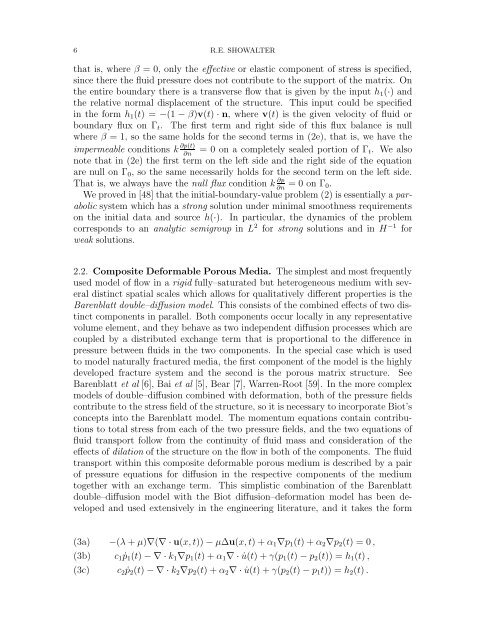Diffusion in Deforming Porous Media - Department of Mathematics
Diffusion in Deforming Porous Media - Department of Mathematics
Diffusion in Deforming Porous Media - Department of Mathematics
Create successful ePaper yourself
Turn your PDF publications into a flip-book with our unique Google optimized e-Paper software.
6 R.E. SHOWALTERthat is, where β = 0, only the effective or elastic component <strong>of</strong> stress is specified,s<strong>in</strong>ce there the fluid pressure does not contribute to the support <strong>of</strong> the matrix. Onthe entire boundary there is a transverse flow that is given by the <strong>in</strong>put h 1 (·) andthe relative normal displacement <strong>of</strong> the structure. This <strong>in</strong>put could be specified<strong>in</strong> the form h 1 (t) = −(1 − β)v(t) · n, where v(t) is the given velocity <strong>of</strong> fluid orboundary flux on Γ t . The first term and right side <strong>of</strong> this flux balance is nullwhere β = 1, so the same holds for the second terms <strong>in</strong> (2e), that is, we have theimpermeable conditions k ∂p(t) = 0 on a completely sealed portion <strong>of</strong> Γ ∂nt. We alsonote that <strong>in</strong> (2e) the first term on the left side and the right side <strong>of</strong> the equationare null on Γ 0 , so the same necessarily holds for the second term on the left side.That is, we always have the null flux condition k ∂p∂n = 0 on Γ 0.We proved <strong>in</strong> [48] that the <strong>in</strong>itial-boundary-value problem (2) is essentially a parabolicsystem which has a strong solution under m<strong>in</strong>imal smoothness requirementson the <strong>in</strong>itial data and source h(·). In particular, the dynamics <strong>of</strong> the problemcorresponds to an analytic semigroup <strong>in</strong> L 2 for strong solutions and <strong>in</strong> H −1 forweak solutions.2.2. Composite Deformable <strong>Porous</strong> <strong>Media</strong>. The simplest and most frequentlyused model <strong>of</strong> flow <strong>in</strong> a rigid fully–saturated but heterogeneous medium with severaldist<strong>in</strong>ct spatial scales which allows for qualitatively different properties is theBarenblatt double–diffusion model. This consists <strong>of</strong> the comb<strong>in</strong>ed effects <strong>of</strong> two dist<strong>in</strong>ctcomponents <strong>in</strong> parallel. Both components occur locally <strong>in</strong> any representativevolume element, and they behave as two <strong>in</strong>dependent diffusion processes which arecoupled by a distributed exchange term that is proportional to the difference <strong>in</strong>pressure between fluids <strong>in</strong> the two components. In the special case which is usedto model naturally fractured media, the first component <strong>of</strong> the model is the highlydeveloped fracture system and the second is the porous matrix structure. SeeBarenblatt et al [6], Bai et al [5], Bear [7], Warren-Root [59]. In the more complexmodels <strong>of</strong> double–diffusion comb<strong>in</strong>ed with deformation, both <strong>of</strong> the pressure fieldscontribute to the stress field <strong>of</strong> the structure, so it is necessary to <strong>in</strong>corporate Biot’sconcepts <strong>in</strong>to the Barenblatt model. The momentum equations conta<strong>in</strong> contributionsto total stress from each <strong>of</strong> the two pressure fields, and the two equations <strong>of</strong>fluid transport follow from the cont<strong>in</strong>uity <strong>of</strong> fluid mass and consideration <strong>of</strong> theeffects <strong>of</strong> dilation <strong>of</strong> the structure on the flow <strong>in</strong> both <strong>of</strong> the components. The fluidtransport with<strong>in</strong> this composite deformable porous medium is described by a pair<strong>of</strong> pressure equations for diffusion <strong>in</strong> the respective components <strong>of</strong> the mediumtogether with an exchange term. This simplistic comb<strong>in</strong>ation <strong>of</strong> the Barenblattdouble–diffusion model with the Biot diffusion–deformation model has been developedand used extensively <strong>in</strong> the eng<strong>in</strong>eer<strong>in</strong>g literature, and it takes the form(3a)(3b)(3c)−(λ + µ)∇(∇ · u(x, t)) − µ∆u(x, t) + α 1 ∇p 1 (t) + α 2 ∇p 2 (t) = 0 ,c 1 ṗ 1 (t) − ∇ · k 1 ∇p 1 (t) + α 1 ∇ · ˙u(t) + γ(p 1 (t) − p 2 (t)) = h 1 (t) ,c 2 ṗ 2 (t) − ∇ · k 2 ∇p 2 (t) + α 2 ∇ · ˙u(t) + γ(p 2 (t) − p 1 t)) = h 2 (t) .
















